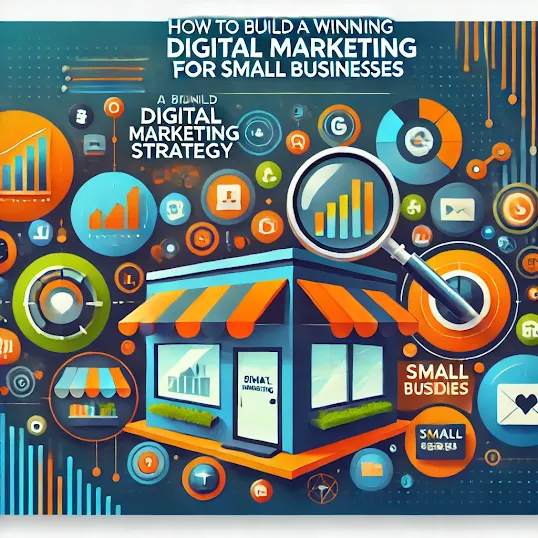How to Build a Winning Digital Marketing Strategy for Small Businesses
Digital marketing is essential for small businesses aiming to thrive in today's competitive landscape. Unlike traditional advertising, it provides cost-effective, targeted, and measurable methods to reach potential customers. However, crafting a digital marketing strategy tailored to a small business's unique needs requires thoughtful planning, execution, and continuous optimization.
This guide outlines actionable steps to create a winning digital marketing strategy that boosts visibility, engages your audience, and drives measurable results.
1. Understanding Your Audience: The Foundation of Strategy
A successful digital marketing strategy begins with a deep understanding of your audience.
Steps to Define Your Target Audience:
- Analyze Existing Customers: Review demographics, preferences, and buying habits.
- Create Buyer Personas: Develop detailed profiles for ideal customers, including age, income, challenges, and goals.
- Use Analytics Tools: Platforms like Google Analytics provide insights into who visits your website and interacts with your content.
Knowing your audience allows you to tailor campaigns that resonate and convert.
2. Setting Clear, Achievable Goals
Goals provide direction and benchmarks to measure success.
How to Set Effective Goals:
- Use SMART Criteria: Ensure goals are Specific, Measurable, Achievable, Relevant, and Time-bound.
- Align Goals with Business Objectives: For instance, if increasing revenue is the focus, set goals like generating 500 qualified leads per month.
- Prioritize Short- and Long-Term Goals: Balance quick wins with strategies for sustained growth.
Defined goals keep your efforts focused and purposeful.
3. Building a Strong Online Presence
Your online presence is often the first impression potential customers have of your brand.
Key Components of a Strong Online Presence:
- Website Optimization: Ensure your site is mobile-friendly, fast, and easy to navigate.
- Search Engine Optimization (SEO): Use relevant keywords, meta descriptions, and high-quality content to rank higher in search results.
- Social Media Profiles: Maintain active, visually appealing profiles on platforms your audience frequents.
Consistency across platforms builds trust and brand recognition.
4. Content Marketing: Educate and Engage
Content marketing is one of the most effective ways to connect with your audience.
Types of Content to Consider:
- Blog Posts: Provide valuable information and establish authority in your niche.
- Videos: Use engaging formats to showcase products, share testimonials, or offer tutorials.
- Infographics: Visually simplify complex data or processes.
- Ebooks and Whitepapers: Offer in-depth insights to attract and nurture leads.
Tips for Content Success:
- Focus on quality over quantity.
- Address common pain points or questions.
- Promote content across channels to maximize reach.
Consistent, valuable content builds trust and keeps your audience coming back.
5. Leveraging Social Media for Engagement
Social media platforms are invaluable for reaching and interacting with customers.
Best Practices for Small Businesses on Social Media:
- Choose the Right Platforms: Focus on those most relevant to your target audience (e.g., Instagram for visuals, LinkedIn for B2B).
- Post Regularly: Maintain a consistent schedule using tools like Hootsuite or Buffer.
- Engage with Followers: Respond to comments, messages, and mentions promptly.
- Experiment with Ads: Use social media advertising to boost visibility and drive traffic.
Social media humanizes your brand and fosters customer loyalty.
6. Implementing Email Marketing Campaigns
Email marketing offers direct, personalized communication with your audience.
Steps to Build an Effective Email Campaign:
- Grow Your Email List: Use lead magnets like free resources or discounts.
- Segment Your Audience: Group subscribers by preferences, behaviors, or demographics.
- Craft Compelling Emails: Use attention-grabbing subject lines, engaging visuals, and clear calls-to-action.
- Measure Performance: Monitor open rates, click-through rates, and conversions to refine campaigns.
Email marketing is cost-effective and delivers high ROI when executed well.
7. Paid Advertising: Accelerating Results
Paid advertising can complement organic strategies by driving immediate traffic and leads.
Popular Paid Advertising Platforms:
- Google Ads: Target users searching for products or services like yours.
- Facebook and Instagram Ads: Reach highly specific demographics with visually rich campaigns.
- LinkedIn Ads: Ideal for B2B marketing and professional audiences.
Tips for Effective Ads:
- Set a clear budget to control costs.
- Use A/B testing to identify what resonates best.
- Focus on compelling ad copy and visuals to capture attention.
A balanced approach combining organic and paid efforts yields the best results.
8. Measuring and Optimizing Performance
Continuous improvement is key to sustaining success.
Metrics to Track:
- Website traffic and bounce rates.
- Conversion rates and lead quality.
- Engagement on social media posts.
- ROI on ad spend and email campaigns.
Tools for Monitoring Performance:
- Google Analytics: For website insights.
- SEMrush or Ahrefs: To track SEO progress.
- Social Media Insights: Platform-specific analytics for engagement tracking.
Regular reviews help identify strengths, weaknesses, and opportunities for growth.
9. Staying Updated with Trends and Technology
The digital landscape changes rapidly; staying informed is crucial.
How to Stay Ahead:
- Subscribe to reputable marketing blogs or newsletters.
- Attend webinars and conferences to learn from experts.
- Experiment with new tools and platforms to assess their potential.
Adapting to changes ensures your strategy remains effective and competitive.
10. Collaborating with Experts When Needed
While small businesses can handle many aspects of digital marketing, sometimes external expertise is invaluable.
When to Consider Hiring Professionals:
- You lack the time to manage campaigns effectively.
- You need advanced technical skills (e.g., SEO, PPC management).
- Your efforts are not yielding desired results.
Working with specialists can save time and accelerate growth.
Conclusion
Building a winning digital marketing strategy for small businesses requires a mix of creativity, consistency, and continuous learning. By understanding your audience, leveraging the right tools, and measuring your efforts, you can create a strategy that drives growth and keeps your business competitive.

Comments
Post a Comment